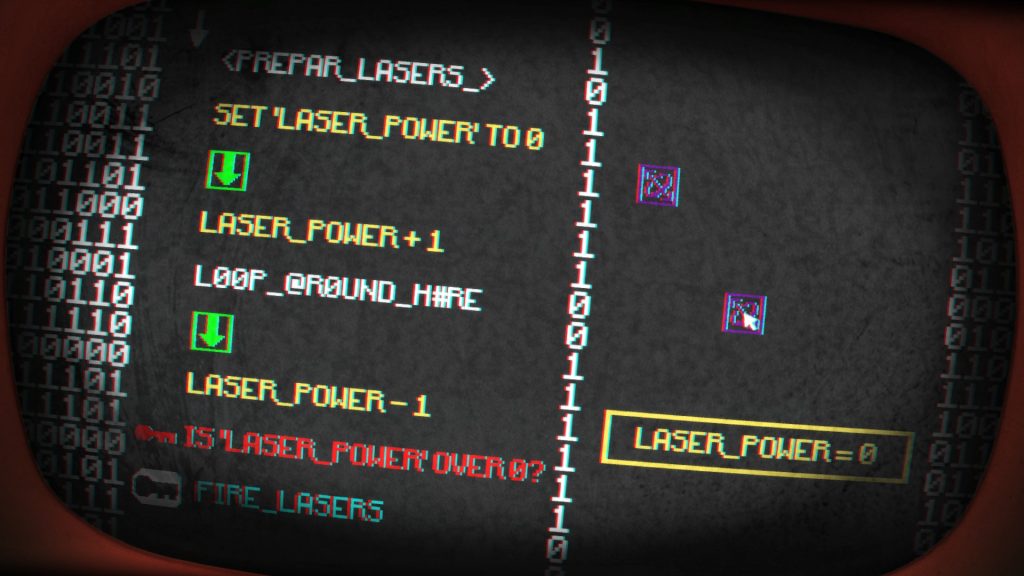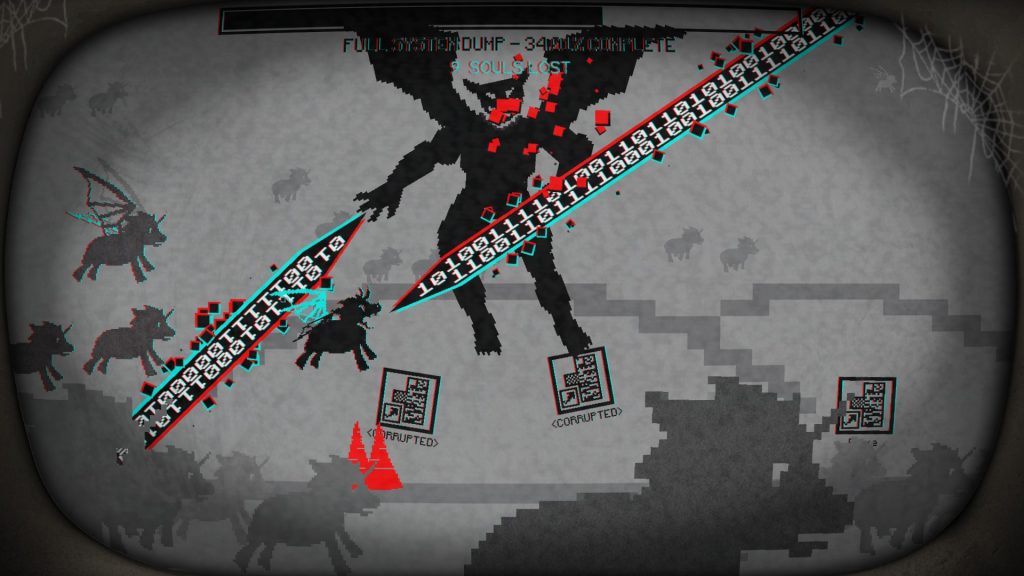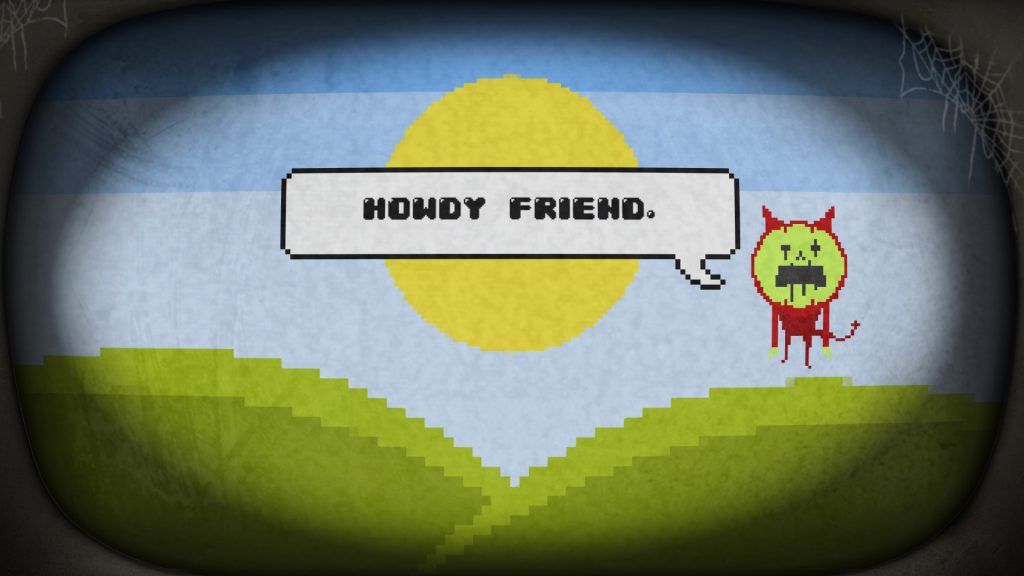Game Name: Pony Island (2016)
Developer: Daniel Mullins Games (Grav, Agent Maxwell: Master of Math)
Platform: Windows, OSX, Linux, Mobile (reviewed on PC)
Categories: On-Rails Adventure, Minimalist Puzzles, Minimalist Sidescrolling Action, Mouse-Only, Dark Comedy, Self-Aware Meta Gaming, Indie Experiment, Corrupted Nostalgia, Interactive Novel
May Appeal To: tongue-in-cheek gamers, weekend vg jaunters, anyone with ‘meta’ in their vernacular, Steam completionists and hoarders, indie snobs, and those looking for mold-breaking conversation starters about the state of our industry.
May Repulse: not many people actually. It’s short and easy – any opposers to that may have a bad time. The stylized CRT retro-graphics might be a bit rough on sensitive eyes.
Comparable To: Five Nights at Freddy’s in terms of simplicity, tone, and the lore-hungry community over-analyzing every snippet or encrypted character dump that appears in frame. The Stanley Parable’s story and game structure is cognitively similar. Pony Island is infinitely easier than every sidescroller, arcade title, and ‘Escape the Room’ style predecessor that it alludes or emulates. Both GlaDOS and Psycho Mantis approve of the narrator/player interactions.
Learning Curve: The most demanding skill is sustaining the left-click button while pressing right-click. Your fear of this combination is proportional to the curve.
Game Length: 3 hours
Difficulty: None to slim. Failure is barely acknowledged and mouse-hovering on everything is valid. A handful of puzzles or jumping sections might take 2-3 attempts.
Mastery: Tickets are scattered across the UI and there are ‘random’ graphical anomalies containing secret messages. Forums and videos could sate your curiosity instead.
Story: It’s actually more straightforward than first appearances: you’re a gamer whose soul is tethered to a glitching, half finished, barely-functioning video game with shoddy production values. (Sound familiar?) You must sever the connection and escape by out-clicking three guardian applications and ignoring the taunts of the daemonic forces.
Presentation: From the developer’s own words, this game is designed to give the impression of not wanting to be played. The electronic burps, static, askew camera angles, [pixelated] satanic imagery, ambient droning, and other queues all reinforce the idea of being unwelcome and that the game does not like you. At times, it emulates your own computer’s error messages and Steam notifications in a convincing bid that there is significant electronic threat, ’cause why stop at soul acquisition?
Unique Features: It plays the player so to speak, using mentalist predictions and a clever implementation of mechanics to disorient your gaming preconceptions. Pony Island’s style embellishes the tropes that it simultaneously embraces and subverts.
Gameplay: At its core is a deliberate and contrasting balance of elements, often directly-referenced by Pony Island itself: ‘And now time for a boss battle’ ‘Have a puzzle for the time being’, it says. The disjointed bouts of play feel akin to beta testing in the least, and an endurance test at the most. Too often, you’re forced to tread that flat field where small hurtles and floating enemies meander your direction – which is the literal game’s eschewment of the virtual game’s true entertainment. In between ‘experimental’ modes and slight variations to the rote pony-jumping sections some twisted developer tosses your way (think wings, precision targets, and enemy swaps), the player stumbles upon desktop icons of Satan’s work station and uses programming portals to sabotage and explore the binary domain of machine language. Graphically, this looks like clicky bits and non-clicky bits. (You click the clicky bits.) Apart from password or keyword entry fields, puzzles are the most conventional elements and is standalone fun in its own right. In them, you swap navigational icons so that lines of code are read in an order that adjusts variable values, bypasses garbled syntax errors, and aligns the key to the on-screen lock.

“Powerin’ mah laser.” Am I programmer yet?
Additional Comments: The flow often goes: pony running, exposition, pony running and exposition, click the glitch, avoid the glitch, psychological flim-flammery, puzzle, exposition, and [now for something completely different] pony running.
What I Liked: The raw design is its best feature. Despite the inherent ugliness of jagged white text, there was a craftsmanship present in the ‘misaligned’ color display of overlapping shadows and the devolving chaos of 1s, 0s, and scant graphical assets vomited upon the screen in a manner that exhibited a total lack of control while obviously being well within the game’s boundaries the whole time. Use of drunken camera angles, parallax, and that pinching effect you get on curved CRT monitors were all little tricks in nailing an oppressive vibe which embodied Pony Island with sentience. Admittedly, there were times where the errors and overt threats did cause my maintained barrier to waver slightly -that wall we erect to keep belief suspension in check when digesting modern media. After long play sessions and exposure, the smart or unpredictable mechanics (not story) can evolve into something more uncanny and sinister. This is clever and fresh.
What I Disliked: Even for a game ironically espousing the disillusioned nostalgia and creatively bereft publications of our era (or previous eras, I’m uncertain), there was too much pony and too much fields and too much jumping. The interface simplicity was a bit grating at times and even being able to move forward or backward would be a Godsend to break the tedium. “It’s a Devil-designed game”, one might argue; I still find fault.
Glitches Experienced: How would I know? 0_0
I once clicked a ‘ponies.meta’ file in-game that literally booted Pony Island again.
Hours I Played: 3
My Personal Reaction: While playing, I had it in the back of my mind that my review shouldn’t be longer than whatever beer-ringed napkin the Game Development Document was assuredly scrawled upon. Thinking about the conversion of someone’s interactive art into words is definitely not the best mindset to play in, so I’m hoping that my tainted experience can still be strained with a dryer sheet to separate reviewer angst from a distilled and frills-less romp through your very own gamer identity. You may also be intrigued to know that this title originated from a 48-hour coding challenge which was later scrapped together in under 6 months for its final form. I think that’s neat.
Noob Tips: Holding shift while booting the game brings up control mappings. Avoiding any play whatsoever can help the immortal soul stay secured in its present moorings.
Depth and Replayability: There are tickets to collect and plain-sight easter eggs to deconstruct. The game’s very storyline endorses a beat-and-forget mentality though and I’ll be infernally damned if I could bring myself to start at the beginning.
Suggested Value: $5
Where to Buy: Good Old Games, Steam
Subjective Categorical Ranking:
(Platform capabilities are considered for Graphics and Sound)
| poor || bad || average || good || great |
Fun Factor |█████████
Unique Gameplay |█████████████████████
Controls & UI |█████████
Story & Lore |████████████████
Graphics & Style |█████████████████████
Sound & Music |████████████████
—————————————————————————————

The real world analogue is a unionized brony revolution bucking society. Subtle, but there.


